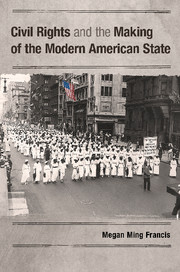Book contents
- Frontmatter
- Dedication
- Contents
- List of Figures and Table
- Illustrations
- Acknowledgments
- Abbreviations
- 1 Rethinking Civil Rights and American Political Development
- 2 The Birth of the NAACP, Mob Violence, and the Challenge of Public Opinion
- 3 The Unsteady March into the Oval Office
- 4 Anti-Lynching Legislation and the Sinking of the Republican Ship in Congress
- 5 Defending the Right to Live
- 6 Civil Rights Bound
- Appendix Manuscript Sources
- Bibliography
- Index
- References
1 - Rethinking Civil Rights and American Political Development
Published online by Cambridge University Press: 05 June 2014
- Frontmatter
- Dedication
- Contents
- List of Figures and Table
- Illustrations
- Acknowledgments
- Abbreviations
- 1 Rethinking Civil Rights and American Political Development
- 2 The Birth of the NAACP, Mob Violence, and the Challenge of Public Opinion
- 3 The Unsteady March into the Oval Office
- 4 Anti-Lynching Legislation and the Sinking of the Republican Ship in Congress
- 5 Defending the Right to Live
- 6 Civil Rights Bound
- Appendix Manuscript Sources
- Bibliography
- Index
- References
Summary
What’s past is prologue.
– William ShakespeareThis is the sort of work which the National Association for the Advancement of Colored People is doing. It is a broader question than that of obtaining justice for Negroes. It is a fight for the high principles which we as Americans revere.
– Walter WhiteIt was a dreary night on September 30, 1919, when a small group of African American tenant farmers peacefully gathered in a church in Phillips County, Arkansas, to organize in seeking relief from the sharecropping system that kept them as virtual slaves to their white landlords. However, the meeting would not end in success. Aware of the union of African Americans, a small band of white law enforcement officials disrupted the gathering by firing shots into the church, first shattering the ceiling lights and then aiming at the frightened men, women, and children trapped in the darkened building. Their fire was returned with fire from inside the church, and one white man was killed. Declaring that the African Americans were forming a plot to kill the “good whites” of Phillips County, prominent whites called on the Ku Klux Klan and other white vigilante organizations from neighboring states such as Mississippi and Tennessee to quell the fabricated insurrection by African Americans. What ensued in Phillips County would become the worst display of racial violence up to that point in the twentieth century: more than 200 African American men, women, and children were indiscriminately hunted and shot down over the course of three days. Thousands were driven from their homes, and the African American section of town was looted and destroyed. When the dust cleared, seventy-two African American men had been arrested. After swift trials dominated by a bloodthirsty mob, all seventy-two were found guilty, and twelve were sentenced to death by the electric chair.
- Type
- Chapter
- Information
- Publisher: Cambridge University PressPrint publication year: 2014



